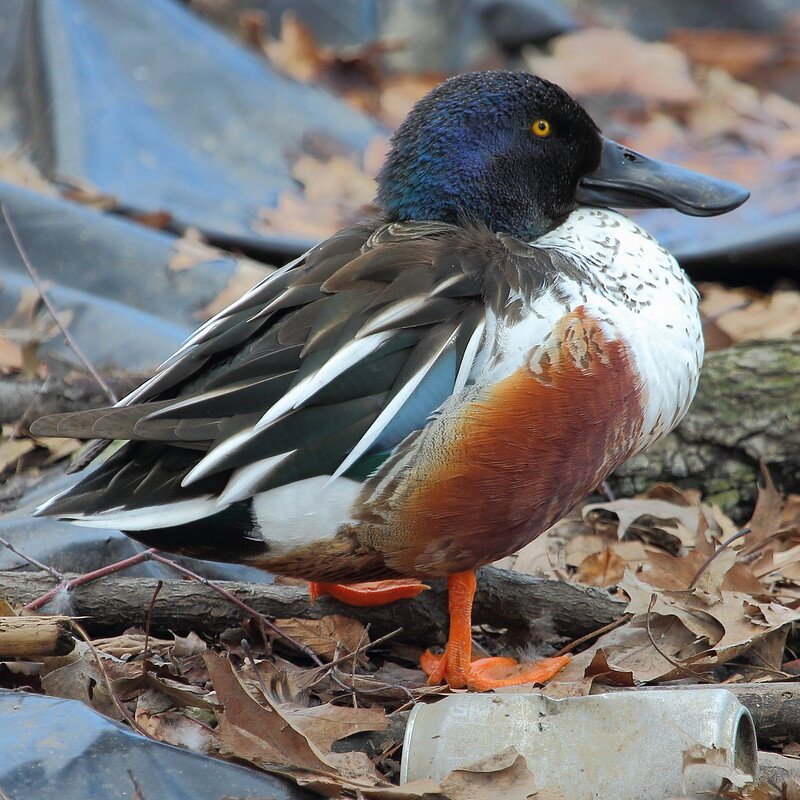The northern shoveler also referred to as the shoveler in the United Kingdom with Latin name of Spatula Clypeata is a common and ubiquitous duck. The northern shoveler is a dabbling duck of modest size. Its most distinguishing characteristic is its enormous shovel-shaped bill.
The northern shoveler is one of the species included under the African-Eurasian Migratory Waterbirds Agreement (AEWA).
Quick Overview: Spatula Clypeata – Northern Shoveler
Body size: Around 17-20 in (43-51 cm) and a weight of 1100 g (38.8 oz)
Main colors: Green, Orange, Yellow, Black, Brown, White, Orange-Brown
Range: Throughout the United States
Migratory Bird: Yes
Best time of the year to see in the U.S.: Janaury, February, June, July, August, September, December
Conservation Status: Least Concern
Northern Shoveler Description
A medium-sized dabbling duck with a large spoon-shaped bill, this is a medium-sized dabbling duck. Males are dark green in color with a dark beak, orange legs, yellow eyes, white breast, and chestnut patch on the flanks; females are mottled light brown with an orange-brown bill and legs and dark eyes.

Size
These birds have a length of 17-20 in (43-51 cm) and a weight of 1100 g (38.8 oz). Their wings could range from 27-33 in (69-84 cm).
Feeding
Northern shovelers are carnivores that hunt aquatic invertebrates such as mollusks, insects, crabs, small minnows, and even small fish with their highly specialized beak. They feed primarily on seeds and aquatic plants during the winter.
Habitat
The northern shoveler is a marsh and prairie pothole specialist. It requires shallow water environments with muddy bottoms.
Behavior
Swimming and flight are the primary forms of movement. Walks freely on the land, although rarely for great distances, especially when females are cautiously traveling to nest or carrying ducklings to water. Head and beak are lowered in flight; the bird’s long neck, head, and bill give it a “hunched-back” appearance.
Spatula Clypeata Scientific Classification
- Kingdom: Animalia
- Phylum: Chordata
- Subphylum: Chelicerata
- Class: Aves
- Order: Anseriformes
- Family: Anatidae
- Genus: Spatula
- Species: Spatula clypeata
Best time of the year to see
The best time to see these birds in the United States is during the summer season (June – September) in the Northern part and during the winter season (December to February) in the Southern part.
Distribution of the Northern Shoveler in the USA
It breeds throughout northern Europe and across the Palearctic and across the majority of North America, wintering in southern Europe, the Indian subcontinent, Southeast Asia, Central, and South America, and the Caribbean. It is a rather uncommon migrant to Australia.
The Northern Shoveler can be found in the following states in the United States – Alabama, Alaska, Arizona, Arkansas, California, Colorado, Connecticut, Delaware, Florida, Georgia, Hawaii, Idaho, Illinois, Indiana, Iowa, Kansas, Kentucky, Louisiana, Maine, Maryland, Massachusetts, Michigan, Minnesota, Mississippi, Missouri, Montana, Nebraska, Nevada, New Hampshire, New Jersey, New Mexico, New York, North Carolina, North Dakota, Ohio, Oklahoma, Oregon, Pennsylvania, Rhode Island, South Carolina, South Dakota, Tennessee, Texas, Utah, Vermont, Virginia, Washington, West Virginia, Wisconsin, and Wyoming.

